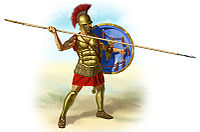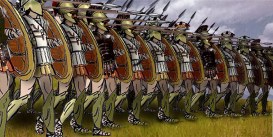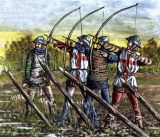Armies - Historical Sketch



1) Hoplite in the 4th century BC. He wears a Thracian helmet, muscular cuirass with leather pteruges, greaves and is equipped with a spear (doru), the xiphos and the hoplite shield (aspis). By that time, many city-states had standardized the dress and equipment of their soldiers, producing a more uniform appearance. 2) Greek Phalanx advancing in close ranks. 3) Longbowmen at the battle of Agnicourt.
In the former the horses were protected by armour. The riders were armed with lance, sword, and mace, and were covered from head to foot with very heavy armour, which rendered them quite helpless when unhorsed. The foot- solders were also divided, into two classes - archers, with bucklers and steel caps, and armed with longbows, swords, battle-axes, and brownbills; and the light infantry, with iron gloves and long knives. The infantry branch of the army was greatly neglected, its training uncared for, and its fighting power regarded with contempt by the leaders and mounted soldiers.
The events which led to the downfall of the feudal system were as follows; 1. The success of the English archers against the French at Crecy in 1346, at Poitiers ten years later, and at Agincourt in 1415, England having practically abandoned the feudal system under Edward III. 2. The victories of the Swiss infantry, which was armed with sword and halberd, wore no armour, and fought in wedge-shaped masses, at Morgarten(1315), Sempach(1386), Granson(1476), Morat(1476), and Nancy(1477). 3. The introduction of standing armies, chiefly infantry, and at first largely composed of foreign mercenaries, but later assuming more of a national character. Charles VII. of France was the initiator of this movement, which he originally started with the idea of rendering himself independent of the barons. The compagnies d'ordonnance in 1445, the francs-archers, and, later the pikemen and landsknechte, provied completely the superiority of a standing army to a feudal militia.
3. Armies after the introduction of gunpowder. The rise of standing armies and the development of the use of gunpowder proceeded contemporaneously, but it was long before firearms superseded bows and pikes. Although a small cannon was used at Crecy, the musket did not become the recognized arms of the food-solder until over two hunderd years later. During this period every improvement in firearms gave increased value to infantry, which gradually took the place of cavalry as the principal arm. The feudal militia of the middle ages was followed by a system of voluntary enlistment in time of peace; if necessary, the standing army was increased by compulsory levies in time of war. Armies were raised by contract, the king paying a fixed annual sum for this purpose to certain of his nobles. The latter commanded the regiments which they enlisted, and selected captains, who usually raised and ommanded the companies under a further contract with the nobles. Regiments were at first very strong, often mustering 3,000 men; but as the use of firearms increased, a more open fighting formation was adopted to avoid severe loss. The old company, 500 or 600 strong, became thereby too extended for efficient control by its captain, and was reduced in number, with the consequent reduction in number, with the consequent reduction in strength of the regiment.
The 18th century practically witness the foundation of present day army tactics and organization. Under Frederick the Great the Prussian army gained a high reputation among European nations for maneuvering power; and the efficacy of a combination of rifle and bayonet in fighting was firmy established by the experiences of the Seven Years' war (1756-63). The armies of the French revolution a few decaded later were organized on Frederick's system of brigades and divisions, and at first were raised entirely by voluntary enlistment. The extraordinary success of Napoleon's arms attracted recruits and for some time no difficulty was experienced in raising enormous armies. But the long-continued wars with almost every nation of Europe eventually drained the country of the class willing to volunteer for service, and compulsory enlist- ment became necessary. In 1798 a law was made authorizing conscription by which every able-bodied man was compelled, if called out, to serve for at least five years. To keep pace with France, other nations were forced to adopt the new system,until finally, England was the only European exception to the rule of compulsory service. A further development of the scheme occurred later, when Prussia, originated the idea of short service in the regular forces, followed by a long period in the reserve, every man in the latter being liable to service in an emergency, and being obliged to go through an annual training. In this way the whole manhood of a nation became trained in the use of arms. The system was copied by other powers, with the result that now the principle of 'compulsory enlistment, short service, and reserve' is in universal vogue among the continental nations of Europe.